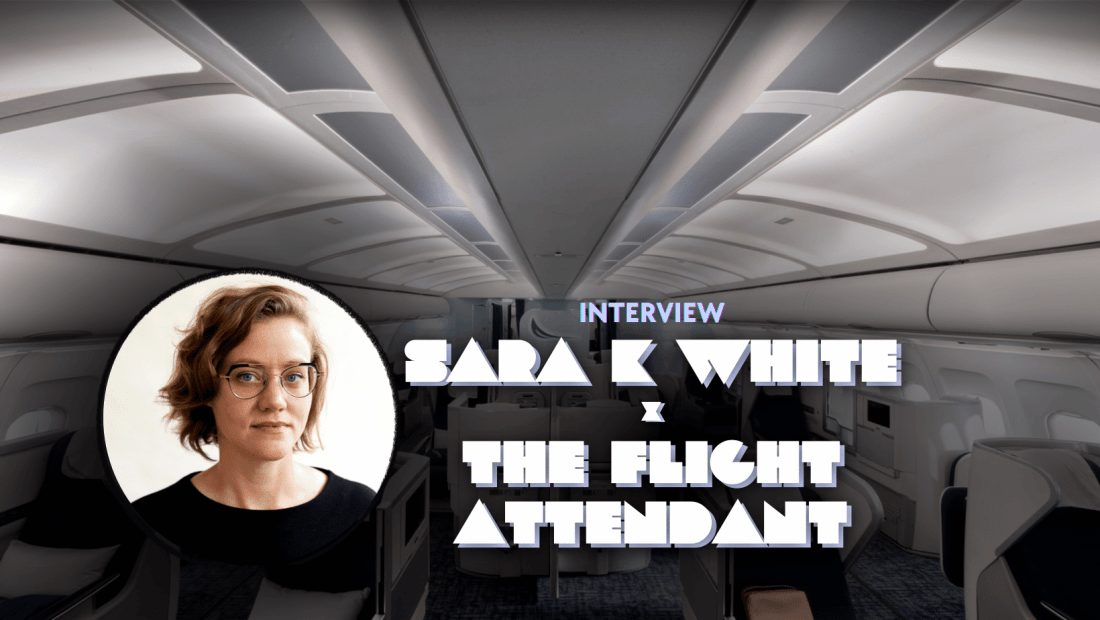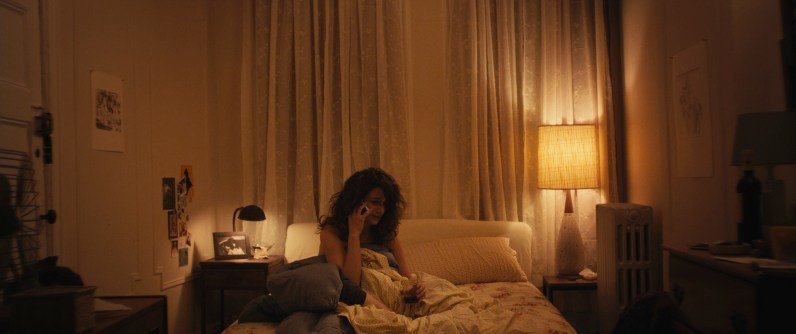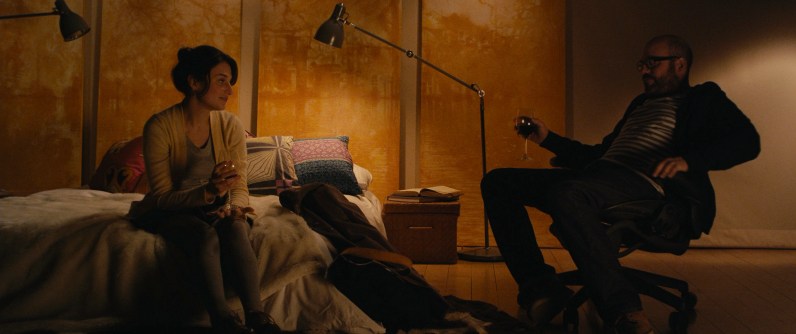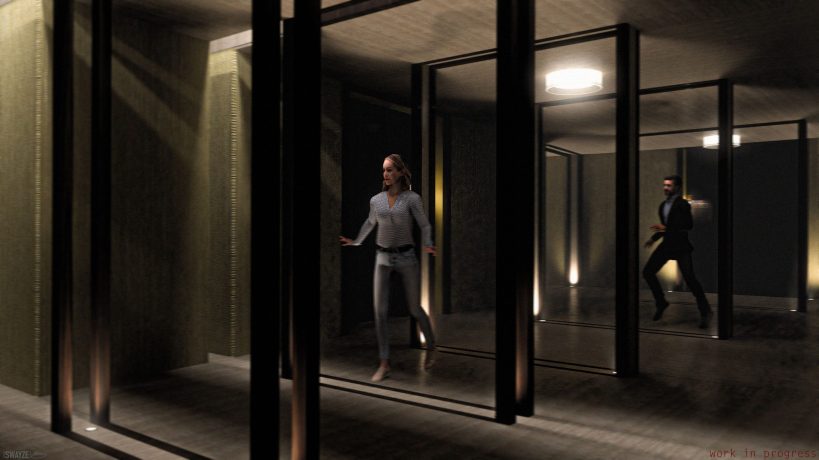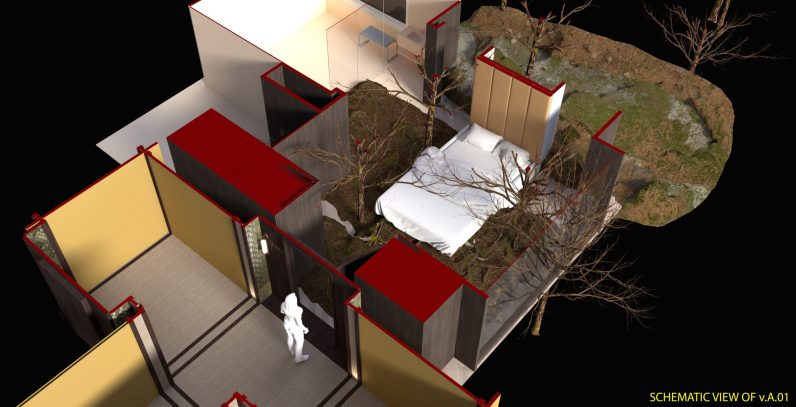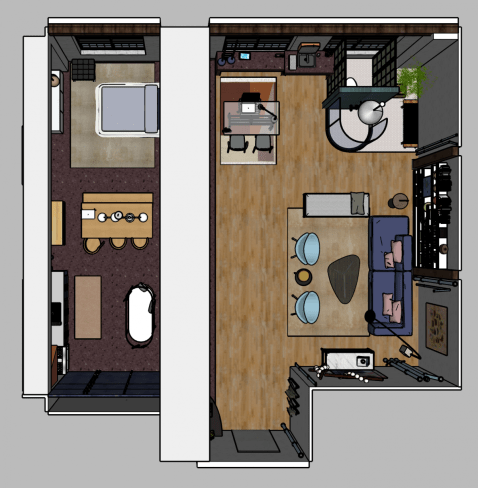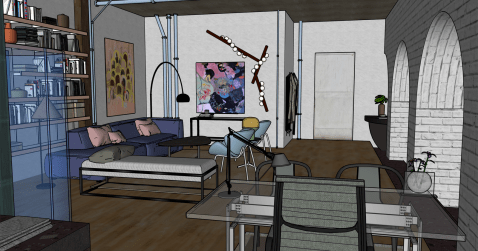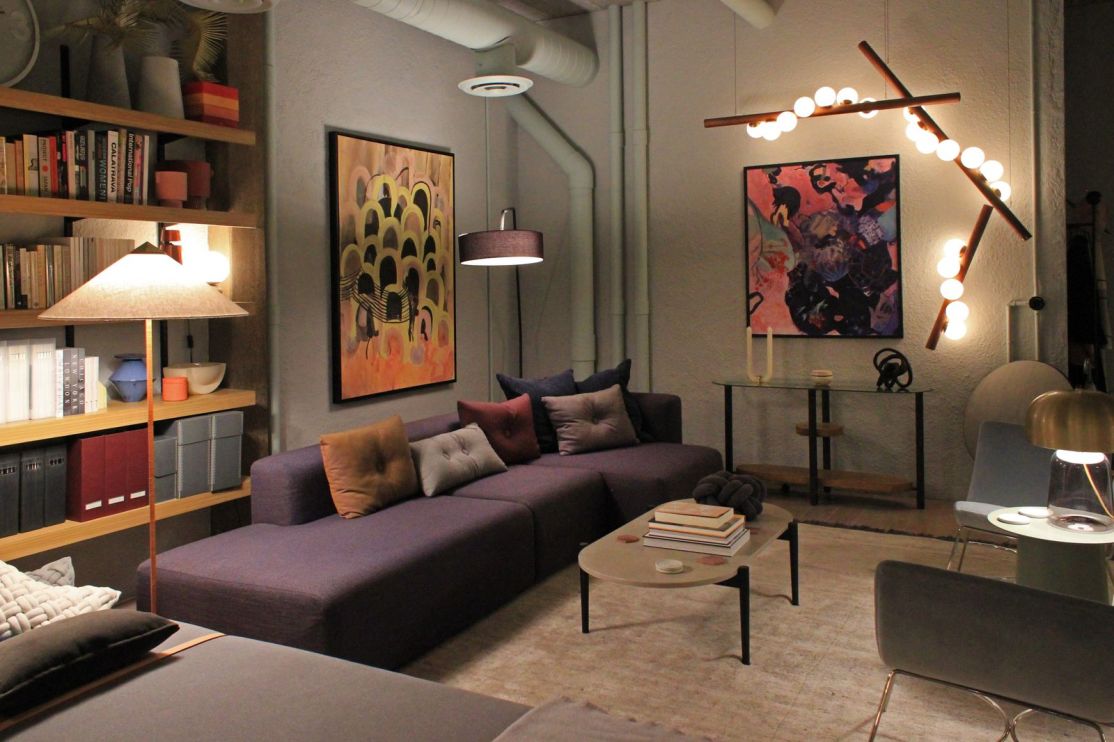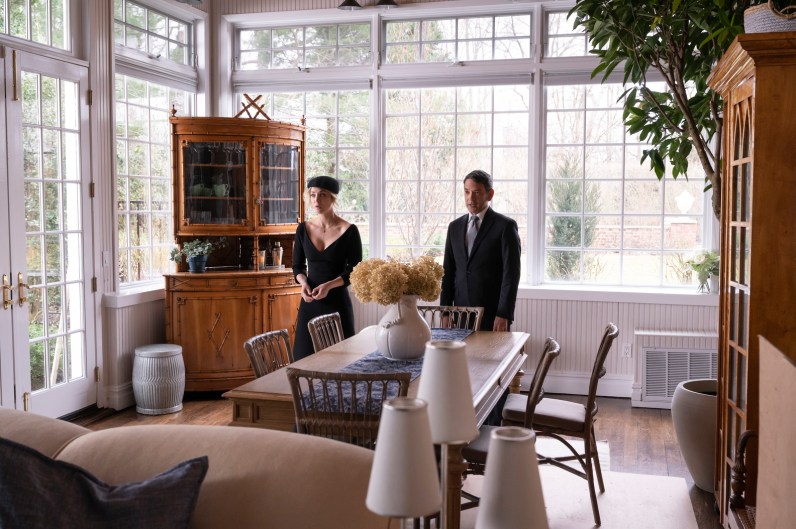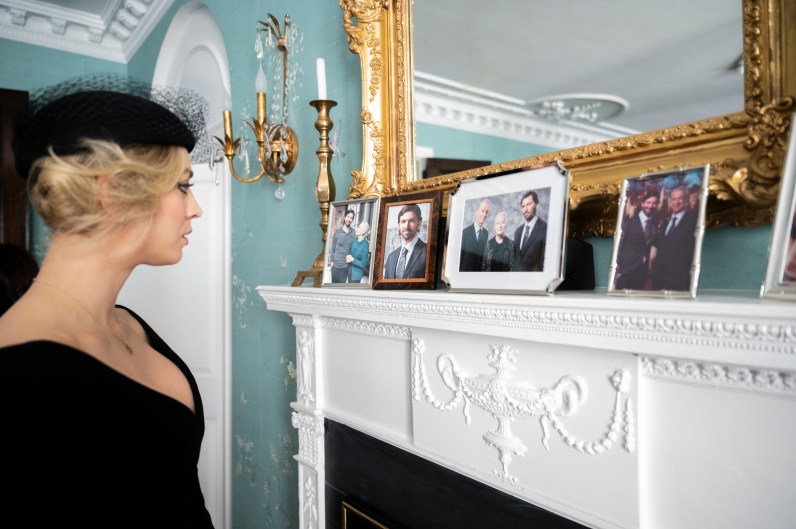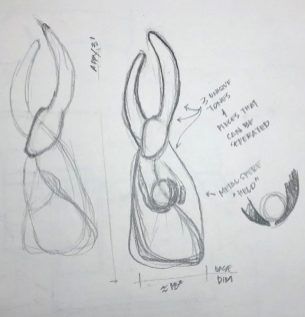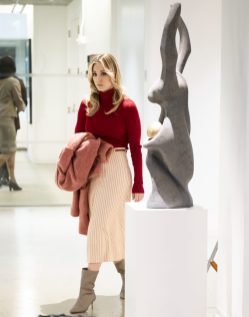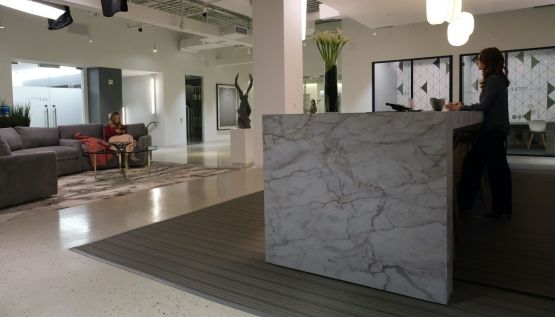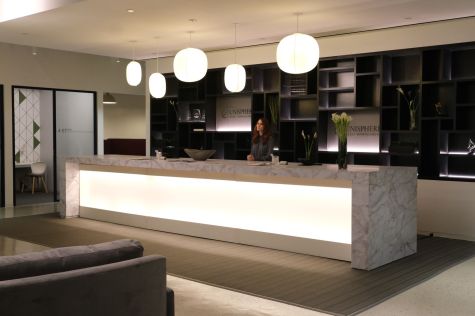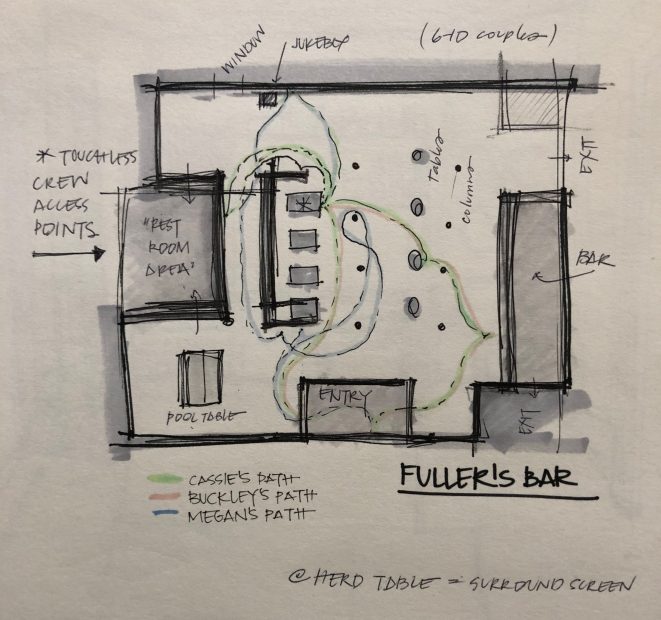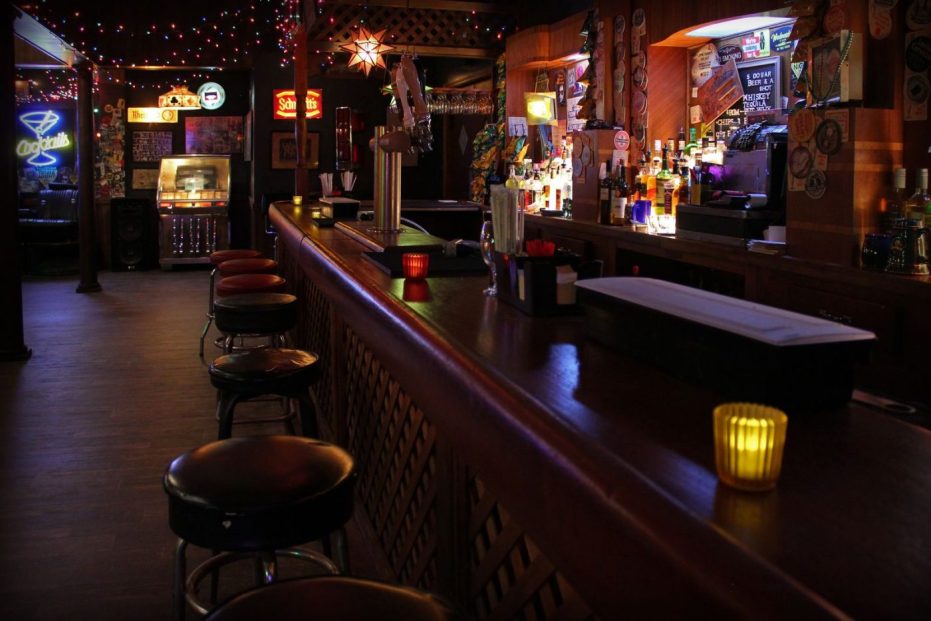I recently enjoyed The Flight Attendant‘s production design so much that I felt the need to find out how they accomplished it. Luckily, I was able to speak with The Flight Attendant’s production designer, Sara K White, about her work creating the visual aesthetic of the series with her fantastic team. Sara is currently nominated for her work on The Flight Attendant at this year’s Art Directors Guild Awards.
“I think everyone is affected by their space, and their space is affected by them.”
If you haven’t seen The Flight Attendant yet, the show is a fictional comedy and drama about an American flight attendant named Cassie Bowden, played by The Big Bang Theory‘s Kaley Cuoco. Cassie struggles with many things, for example, alcohol, friendships, and relationships.
When Cassie wakes up in a hotel room in Bangkok with a hangover from the night before, she discovers the dead body of a man who was on her last flight lying next to her, his throat slashed. Afraid to call the police, she cleans up the crime scene and then joins the other airline crew travelling to the airport. Still unable to piece the night together, suffering intermittent flashbacks and hallucinations, she begins to wonder who the killer could be.
While much of the show’s strength comes from Cassie’s life and characteristic humour, the show’s whodunnit suspense and action framework complement the equally stellar ensemble cast. The show never strays away from its quirkier elements, allowing the show to be visually stylized to a certain degree, particularly during flashbacks. Given the sheer amount of murder thrillers on television these days, I was impressed with how fresh the show looks and feels.
If you watched too and wondered how they successfully accomplished the show’s look, feel, and tone, you’re not alone. Below, you’ll be able to see precisely how The Flight Attendant production designer Sara K White and her various teams created all of these great sets, including the airplane, the hotel suite, and Annie’s magnificent loft, to name only a few.
The Flight Attendant Production Designer Sara K White Talks on Fuselage, Polar Bears, and Designing During a Pandemic Share on X
Sara K White Q&A Table of Contents
- How Sara K White Started in the Art Department
> The Challenging Nature of Getting Your Big Break - Getting Started on The Flight Attendant
> Building The Flight Attendant‘s Art Department
> Collaborating on Set Decoration
> Designing with Action Sequences and Visual Effects in Mind
> Location Shooting in Rome and Thailand
> The Art Department in Italy and Thailand - Shooting Schedule Delayed Due to Worldwide Pandemic
> Getting Back to Work During an Active Pandemic - The Flight Attendant Production Design Process
> Designing the Makara Prince Hotel Suite
> The Hotel Flashback Sequences Flourish
> Creating the Imperial Atlantic Airline
> Playing with Private Spaces in Annie’s Apartment
> Creating Character in Cassie’s Apartment
> The “Old Money” Look of the Sokolov Mansion
> Old Meets New at Alex Sokolov’s NYC Penthouse
> The Unisphere Corporate Head Office Transforms
> Building a Hospital After Lockdown
> The Transforming Fuller’s Bar Set
- How Sara K White Started in the Art Department
**Spoilers Ahead**
Interview with The Flight Attendant Production Designer Sara K White

Sara K White’s hotel design process on The Flight Attendant
How Sara K White Started in the Art Department
How did you get started in the art department and production design?
I went to school for interior design. I liked the idea of creating spaces that affect people – there was a time when I wanted to do architecture but responded most to the intimate human experience of interior design.
Once I graduated, I came to New York to do corporate interior work and found it wasn’t as invigorating as I’d hoped. I didn’t feel like I connected to the people I was designing for, which wasn’t in keeping with my career goals.
As I was working through that, I was friends with a group of filmmakers working on a music video who needed someone who knew about art. They came to me and asked if I could help them out by building a forced perspective miniature 1950s mermaid set.
I was just blown away by how inventive it was to design for film. I immediately said, “Okay, how do I leave my corporate job and get into filmmaking?” From there, I made that the path for my life. I was so fortunate to have friends who brought me along at the very beginning of my journey, and I’ve been doing it ever since.

Pariah (2011) | Production Designer: Inbal Weinberg | Art Director: Sara K White | Focus Features
How did your career unfold? Did you work your way up through music videos at first?
It was really start and stop. I jumped careers right in the middle of the 2008 recession, so that was a perfect time to move into independent cinema because there were so many jobs paying so much money [laughs]. So I took on jobs with friends.
Everybody I was collaborating with had just started out, we did so many short films and music videos, some pilots for web series. Back then everyone thought a web series was a weird idea, that no one would ever watch them. Funny now to think that in 2008 streaming content was a joke. And here it is, driving so many careers now.
I was often a one-person art team for a lot of those projects because they were so small. It was 5 or 6 people trying to do an entire crew’s work and experiencing career growth together. I went from being the whole team to being an art director to a production designer leading the art department team.
Who were you working with as an art director back then?
I worked a lot with Inbal Weinberg. We were friends before I made the leap, and she was so kind to bring me onto the film Pariah many years ago. That feature film was the first time that I art directed, it was a really special experience.
Table of Contents
The Challenging Nature of Getting Your Big Break
Obvious Child (2014) | Production Designer: Sara K White | A24
I saw you designed Obvious Child, which turned out to be quite a successful film in the end. It was an independent film, but it did really well. I loved that film so much. Did that film feel like your big break at the time?
That’s so interesting. That was my most recognized project for a very long time and still has a lot of name recognition with people. It definitely helped during the interview process – producers suddenly saw me as someone who could take a project, envision it and create something watchable.
It was an incredibly small film, as were all the projects I started out doing. These tiny, spirited independent films, a place where my heart still lives. I love creating spaces for dynamic characters and supporting their narratives. The most challenging stories can come from the indie realm, and that’s where a lot of my connections were when I started, so it worked well.
It felt like it was a big break to the extent that I was seen as a legitimate designer, but it was also— working on independent cinema and trying to claw a livelihood out of that was very, very challenging. It hasn’t been until the last few years where the cumulative effort of a lot of those independent projects paid off, and my career path became sustainable. [laughs]
I remember a story that I read where production designer Scott Chambliss said that he was ready to quit production design because he wasn’t getting any opportunities to design the types of shows he craved.
Soon after, he met a new showrunner named J.J. Abrams, and they hit it off. He landed Felicity, thereby changing his entire career trajectory to the major leagues of action films.
You can call it luck, but some of a production designer’s career journey is just waiting for those magic moments when suddenly everything falls into place.
Yes, I think that really happens. That’s the thing– when Obvious Child started playing, and it got on Netflix, I remember my cousin telling me, “Oh my gosh, you’ve got a film on Netflix, you’ve made it!”, and meanwhile, at the time, if I didn’t get a job that week I was not going to be able to pay rent.
It’s a strange world to be in because the understanding of what filmmaking or Hollywood is, by the larger population, is very limited. Workaday people in Hollywood live very different lives than the stars and have very different career paths. Making it looks very different, but you just keep chipping away as long as your heart’s in the work.
Table of Contents
Getting Started on The Flight Attendant

The Wilds (2020) | Production Designer: Sara K White | Amazon Prime Video
How did you get involved on The Flight Attendant?
It actually came from doing The Wilds. I happened to be in LA visiting some friends, and I was talking to my agent who told me there was this great TV pilot and asked if I would meet with them since she thought I would be a good fit. At the time, I hadn’t been that interested in television.
I hadn’t been around a lot of people who had done television and liked it. Prestige TV was happening, but not in my immediate circle. Colleagues didn’t have positive experiences with it, so I was hesitant. I’m so glad I met with the showrunner and director anyway.
There, I met Susanna Fogel, the director for the pilot of The Wilds and Sarah Streicher, who was the creator, and we all hit it off, so I went with them to New Zealand to do the pilot for The Wilds. In that creative collaboration, Susanna and I ended up becoming quite close.
When she got the pilot for The Flight Attendant, she was like, “You have to come with me. I really want you to be on this project. Let’s figure this out.” So we started chatting about the project, and she got me a meeting with the other showrunners. I had one phone conversation with them, and we all just clicked.
We spoke the same language about how we perceived the characters and the story. Steve Yockey, Meredith Lavender, and Marcie Ulin decided that Susanna could bring me on and we set off.
Table of Contents
Building The Flight Attendant’s Art Department

Can you tell me about the makeup of your art department and how it was structured?
I got really lucky. I ended up working with some amazing ladies on this project. Christine Foley was my art director, she previously worked on The Deuce, and her name came across my desk at the very last minute when I was looking for my art director and I knew I had to snap her up.
My set decorator was Jessica Petruccelli, who I had known about for years. She was friends of friends with so many people I respected. I had been chasing her for years, hoping to find a job that she would come onto with me. When she did, I found I’d worked with some of her assistant set decorators, and it was fun to have them on as well, a lovely little reunion.
We had Courtney Schmidt as prop master, who came on after episode 2 and continued our series with us. She’s a phenomenal prop master and a wild and amazing lady. I’ve often been the only woman department head or key on a show, but it was pretty special that by happenstance all of these incredible women converged on the show, each helming strong teams below them.
Given how many builds there were on this, how many set designers did you have?
We had a primary lead set designer for the amort sets when we started, named Josh Smith, and we had two set designers, Katie Citti and Abby Smith, along with us at the very beginning. As we moved past those amort sets, Josh went onto another show and the rest of our team rose to the challenge.
So would you say that once you all came back, the majority of the art department was working from home?
I’d say about half. Half were working from home. It was tough to work in a medium where the goal is to create something visually pleasing to the eye when you’re not all able to stand in front of it and look at it. As much as we tried to keep people home, there were many times for communication purposes we might have our graphic designer, for example, come in for a day.
We made sure they were tested and were obeying all of the protocols that would make their occasional arrival to our office a safe one. There were times where it became a much more efficient way of working.
How much prep time did you guys have?
We ended up having 12 weeks of prep before we went to camera. We also had a couple of weeks where we were scouting in Thailand that we used to finish construction. It wasn’t necessarily the most efficient experience when trying to run an art department in New York while on the other side of the world. You’re literally working 24/7 when that happens.
Collaborating on Set Decoration
How do you work with your set decorator? Are you big on approving each thing, or do you give a lot of freedom? How involved are you with the set decoration?
I do get pretty involved. I’ve been so lucky to work with so many set decorators that I trust and have incredible reads on the scripts we work on. I love bringing concepts to them and telling them what’s important about the different sets, the feelings I want to evoke for our characters, our actors, and our audience.
I give them those ideas and let them go and see what they bring back. I hone it down with them from there. I hope I don’t micro-manage, but I’m definitely collaborative. I think if I were to be completely hands-off, I wouldn’t be as invested in the career. Set decoration is often the most human aspect of a design, and that’s what led me to this career from the very beginning.
I think everyone is affected by their space, and their space is affected by them in so many ways. Say, where you put your chair can affect how you start your day when you sit down at your desk. The way that you organize what you want around you when you’re going to start your workday– it says so much about each person. That’s how I connect with the characters, so I want to be a part of that process when designing these characters’ spaces.
What was the most challenging set for you?
The Makara suite in that it was so critical to get it right, and so that process felt very weighty, but I think that the logistics of getting the plane to come together was the one that felt like a real challenge.
Table of Contents
Designing with Action Sequences and Visual Effects in Mind
There’s a lot of car accidents, fight sequences, stunts, visual effects, and special effects. Had you dealt with this type of action work before? It tends to be a lot more work than people realize, liaising with all of these various departments to make it all work.
I’ve done a few different projects that had elements of that. I did an apocalyptic film called Bushwick that was very small but required a fair amount of CG and stunt work, and so I sort of got my feet wet there on how to liaise with stunts and VFX.
I was also so happy to work with our VFX team, Fuse FX, and our stunt coordinator, Mark Fichera. They were easy to work with, and the communication was always very open. We were always bringing ideas to each other.
I get anxious just looking at fight sequences when they affect the set as I know it’s likely a lot more work or at least a different form of design work.
Yeah, I have to say, something I learned many years ago is to always test your walls if somebody is throwing themselves at them. You’ve got to get that construction up securely, test it, reinforce it. It’s all about communicating needs with the construction coordinator to make sure it’s safe.
Location Shooting in Rome and Thailand

It’s great that the Rome shoot was pushed up in the schedule.
It is really wild. I’m always an advocate of shooting in story order when you can. For me, when we started talking about putting the finale of the project right in the middle of our shooting schedule, it seemed like maybe we were going to end up compromising parts of our story if we did this.
Obviously, that’s well outside the realm of my decision-making, so of course I went along with it, and it ended up being the best decision we all could have made for the project.
So what did you shoot in Rome? Just the exteriors, or did you do more there?
Yes, we shot the exteriors there and the moped ride. We shot Enrico’s grandmother’s place, which was spectacularly beautiful on Rome’s outskirts, and we shot some lobby work for Cassie’s hotel – a budget flight attendant hotel in the middle of a fabulous city.
We had more work there so we built a match set back in the States. It was a lot of work to build the feeling of Rome and the texture of the city. Enrico’s family home and that little bistro where he works were also shot in Rome.

So in Thailand, you also shot exteriors there. What else did you shoot? Did you shoot at their airport? Speaking of that– how did you complete all those airports?
We shot the airports both in Thailand and Rome. Airports are very challenging to film in. No one wants a film crew shutting down any portion of an airport, so for JFK, we shot in Islip Airport, and we redressed that to make it feel bigger.
When we shot in the Rome airport, we were given a minimal footprint to work in. We were permitted very few extras inside the airport, so my head is actually sitting there somewhere in one of those seats as a background extra trying to fill up space along with several other crew members.
In Thailand, we were only allowed to shoot a couple of areas near the check-in counter. We had a very, very limited area where we were allowed to shoot. It speaks to how our production team collaborated with the local production crews to make it happen. Our teams were respectful, so we could pull off all of those things without interrupting or putting out those airports’ local users.
I think it was really special to shoot at the Rome airport as it has a very distinctive look. When you see Cassie coming off the plane, the gates are uniquely Rome. There’s a lot of architecture in that space that shows its hand as a part of the culture. It was really important to us to make Cassie’s journey as she travels the world feel as authentic as possible.
Table of Contents
The Art Department in Thailand and Italy

How did you guys work with the art department in Thailand and Italy?
It was such a treat to work with the teams there. In Thailand, I worked with an entirely Thai crew. I was the only representative of the art department that travelled there. I had an amazing crew out in Thailand. Whay Sitthirak, my Thai art director, just blew me away with his skills, and his team was just fantastic. I had the same experience in Rome — Guilia Camoglio headed my team there and collaborated with us when we needed to bring the details back to the set in the US.
We did bring our prop master out when we were in Rome because we had already established several props that we felt like we needed to track, but otherwise, we worked with the terrific international crew. It was great having them to make the global travel be authentic.
Were there language barriers– were you working with a translator?
There were definitely language barriers. I had an art department translator Chat Somprasertsak who is an amazing human. He is a Thai guy who actually came to New York, went to architecture school and then went back to Thailand. He was my translator, and he’d worked with my Art Director before. He understood what the art department does so it was quite seamless.
My Italian art director spoke English really well, and a lot of the crew there spoke some English. I very quickly learned how to say thank you, and unfortunately, that’s where it ended, but that was a word I was saying a lot because they were great.
Table of Contents
Shooting Schedule Delayed Due to Worldwide Pandemic

I read somewhere that you were on the show for 12 months, so you finished shooting in mid-October, less than a month and a half before the show premiered. Is that correct?
I came onto the show in August of 2019, and we were initially slated to finish by February of 2020. Dates slid around as they can, so once we were up and going we planned to wrap at the beginning of April.
We went to Thailand first. We had planned to go to Rome at the very end of the schedule, but we decided to pull that forward into January, thankfully. We shot in Rome in January, and then four weeks from finishing the show– COVID hit, and we had to shut down. We went on a snap hiatus, and of course, like everyone else, we thought it would be two weeks, maybe four. It couldn’t possibly be longer than that [laughs].
We’d shot all of episode 5 and two days from the beginning of episode 6, and then that was it. We went down, left everything standing, and walked away. I think somebody had gone back the next week to make sure all of the half-eaten sandwiches and crafty were out of the set.
Beyond that — it was Friday the 13th, of course, and we were told we were going to have a long weekend, which very quickly turned into two weeks, and more. A lot of people had left their computers, their personal items in the office not thinking that they would need them before they were able to get back. We walked away, not knowing what the shutdown would mean.
We didn’t end up coming back until the beginning of July, and we did a fast prep before shooting the remaining three episodes. When we came back up, we shot for about a month and a half, wrapping in mid-October.
Having already shot episodes 1 through 5, a substantial amount of editing work had been completed. It made it easier for us to pick up and have the show out and into our audience’s living rooms by Thanksgiving.
Table of Contents
Getting Back to Work During an Active Pandemic

The Flight Attendant set builds created during the pandemic.
How did coming back in July work for you all? Were the new protocols in place by the time you started back up?
We were one of the first out of the gate. We had the White Paper from the unions, but the negotiated terms weren’t fully complete, so we had a side letter negotiated with our production and unions. We used a zone system to keep different groups from overlapping, and we had a lot of testing, a lot of PPE. Warner Bros. provided all of the PPE for our production, so we always had plenty of hand sanitizer and masks and visors.
We learned as we went. We had a constant negotiation discussing what was working and what needed to be reconceived. Luckily we’d been talking the entire hiatus about how we’d be able to get back to work, what would make us feel safe, and how we could best support all of our crew members.
The art department is a wild team, with people shopping, building, running, designing all over the place, so we had to meet the department’s needs while also respecting our safety concerns. It was a real challenge.
How often were you all tested?
It depended on which zone you were in and your proximity with the unmasked actors. Some people worked from home, some people were tested every day, and some were once a week. The majority of us were tested twice a week. We did have some 100% in-office people who were tested once a week.
We also wanted to respect that working from home was the best-case scenario for many of our crew members. Much of the graphics team and the assistant art directors were working from home the whole time.
For clarification, when you say assistant art director in New York, that is the equivalent of a set designer, correct?
Yes, set designer or draughtsperson.
Table of Contents
The Flight Attendant Production Design Process

360 Shot of the Makara Prince Suite | Courtesy of Spencer Lasky and HBO Max
Where did you start with your entire design process on The Flight Attendant? Did you have all of the scripts in advance, or did they trickle in?
We had most of the scripts ahead of time. I think when I started, I had at least four, if not five, scripts. I also had a breakdown from our creator, Steve Yockey, with each episode’s main points and how the overall arc would affect Cassie’s understanding of herself and where her character would go. We had a lot of conversations about the main themes of the show.
I started with the practical needs of the Makara Prince Suite. With the hotel room, I asked myself, “What are the spaces literally scripted in? Where do they need to go within the suite? What does a typical high-end penthouse suite look like?” We were talking about Alex, who is in the one percent, and lives a rarified life. I don’t have as much experience with that as I would like [laughs], so I did a lot of research into how high-end hotels plan out their spaces.
Many of them have a walk-in closet, and kitchenettes, dining rooms– some of them even have grand pianos. There’s a lot of space to play with. Beyond what would be expected, I wondered what would wow Cassie and how we could organize those spaces to make it a place that could continue to evolve.
I talked a lot with Susanna Fogel about various visual themes that we wanted to bring into the space. We talked a lot about reflection, refraction, and obfuscation to allow our in-camera experience to evolve. In part, the themes represented Cassie’s past trauma that she re-experiences as she goes through the story. Alex’s death is activating the PTSD from her childhood experiences which she’s only just now starting to deal with.
I did this massing study that made perfect sense as far as the way the characters would naturally move through the space in the few opening sequences, then I shattered it to create more drama in the floor plan. It loosened up the whole space for the characters and the camerawork.
I really paid attention to creating interesting eyelines, so there’s a lot of symmetry and broken symmetry in there. Things are lined up if you’re standing in one space, then step a few feet away, and you can see something from a totally new perspective that you wouldn’t expect to be able to see.
That was an important part of the design process, and luckily that was received with open arms by our showrunners. They exploited it as they wrote the scripts for the remaining episodes and as some scripts continued being fleshed out. The discovery of the dining room in episode 5 was amplified in the script because of the space that we were able to give them, which was fantastic.
Table of Contents
Designing the Makara Prince Hotel Suite

Makara Prince Hotel Suite | Courtesy of Spencer Lasky and HBO Max
How much influence did you take from Thailand itself for the Makara Prince Suite?
Thailand and Thai architecture was a significant influence. If you see the gold ceiling in the living room, called “fa pakon” panelling which was inspired by my trip to scout in Thailand. We also used materials – the darker woods, gold tones and stone, as well as the carved panels to bring in the sense of place.
I worked with my set decorator, Jessica Petruccelli, who was on board with me trying to bring in pieces that were evocative of Thai design styles. We worked with different vendors in New York to get us all of our artwork from Thailand and Thai artists. We also worked with Jim Thompson’s upholstery and wallcoverings, it’s a Thai-based company with gorgeous pieces.
There are certainly elements of gorgeous high-end hotels that you might see anywhere, but I wanted to make sure that we had some distinct characteristics. We have a lotus pattern that runs throughout the suite. You can see it in the moving screen between the bedroom and the bathroom and in the carved panels that go between the living room and the dining room, and we brought it into some of the textiles in the space.
It was important to me that the suite didn’t feel placeless. For a long time, Cassie found her sense of safety from being constantly in motion and travelling, so I wanted to make sure it felt like we were somewhere specific; not just in a random “nice hotel.”
I loved that finish on the hotel suite’s main wall that looked a bit like agate stone. How did your team accomplish that finish? It looks very authentic.
It was amazing. My scenic team did a fantastic job. We took high-resolution photos, scanned different samples of actual stone, brought those into photoshop and got it to a place where the colours were just right. We then printed those onto gator board and added a resin finish which we buffed, so it was glossy but had a honed texture.
We created that in-house which was an incredible challenge, but it turned out beautifully in the end. We fooled a lot of people with that one.
It was very successful. I really couldn’t tell.
We did many samples, both of the printing process and the resin process, to ensure that we could get it right, and it came down to the wire. With all of these decisions, you only have so much time to get everything right, and you work so hard with your team in that process before you have to put something up in front of camera.
Table of Contents
The Hotel Flashback Sequences Flourish
Was the whimsy of the flashbacks as they move through the hotel from her mind’s eye in the script from the beginning?
It’s interesting. I feel like the amazing comedic and whimsical aspects of the project are so rooted in Kaley Cuoco’s performance of Cassie Bowden. She took many of the elements that we were bringing to the table — which was definitely a part of the show’s vision to go big or go home. As far as bringing comedic moments into it, a lot of that was bouncing off of Kaley in her vision of her character.
When we’re in her mind, and she’s talking to Alex regularly, where was the maze within that realm?
That was the hallway. We ended up building a sort of racetrack-y hallway right off of the suite’s hallway and modifying that to create those different moments to give them space to run. We made sure that we brought in the scripted areas in a way that was as eerie as possible.
The scene of her seeing Alex in bed with the dead deer was scripted in, but the idea of her opening the door to that and marrying the space to her own backyard— that was something that we decided in the design process. Adding multiple Alex’s and bringing her living room into the maze was something that we developed in the design.
It was a really amazingly collaborative process with Steve Yockey and Jess Meyer, which allowed for Cassie’s creepy and unsettling experience as she is trying to escape herself.
Table of Contents
Creating the Imperial Atlantic Airline
You also had to create an airplane and an airline brand. How did you go about that? Had you ever designed and built any aircraft before?
With The Wilds in New Zealand we created a private jet, so I had done a small fuselage, but that was a much smaller piece.
For this, we scoured all US vendors to find something that would give us the very high-end contemporary airline feel that we needed. Most of the elements that we were after were in use by other productions. We also needed to keep the set for our shoot’s duration, so our typical vendors weren’t really in play.
We ended up working with Shooting Aviation based out of the UK. We found them through happenstance– a Google search. I ended up going out to London and spending 24 hours there looking at all of the pieces and parts they had for their airline sets. They had the seating pods, and they also had the galley element, which was cut straight from the fuselage of a plane.
Their galley was unique because it was practical. All of the drawers and all of the doors, everything worked and looked right. It had to all work, but many of the galleys you see as set pieces are not practical. Our production needed to be able to open up a drawer and reach in and grab a small bottle of vodka, for example.
Getting that piece was critical, and getting the business class seating pods was a huge find. We did end up augmenting a lot of stuff and building in our little amenities bar and the ceiling of our fuselage’s central spine. We also brought in all of the finishes.
Did you purchase or rent the pieces? Did you have limitations on what you could do with these elements?
It was a rental that ended up being a business opportunity for Shooting Aviation. The set pieces now live in New York and are available for rental on other projects here. They were welcoming of our adjustments, especially in the galley. We did cut away some of the galley walls to allow for camera ports, and they recognized that we were going to have to do that.
The only stipulation that they gave us was to make sure that other film crews could come in there and shoot it when we were done with it. They didn’t want us just chopping it into bits. It needed to be fully shootable, so it was important for us to respect that.
Table of Contents
Playing with Private Spaces in Annie’s Apartment

Annie’s Loft Living Room | Courtesy of Spencer Lasky and HBO Max
Annie’s loft is really unique. Can you speak about how you came up with the look for it?
What was great about Annie’s loft was how it was scripted, to begin with– Cassie comes into the loft and sees Max, Annie’s boyfriend, naked in the shower. That was the only clear identifier for how the space was organized and what the look was, but it immediately told me so much about the character.
Annie is a bold woman, and she’s an up-and-coming lawyer who is very confident, very sure of herself and doesn’t mind playing fast and loose with the facts, so those were things I took into consideration. I liked playing with the idea of public and private spaces because the script already creates this unspoken dialogue where public and private spaces don’t mean the same thing to Annie as they might to everyone else.
To accomplish this, I brought in the central arches that march down the space and define the two sides of the apartment. Usually, you’d put all of your private areas behind those arches and conceal them away. Instead, I let it be a much more porous wall that didn’t have those same connotations.
I thought it was essential to make her somebody who felt very confident with her design choices, complete and of the moment. She landed this fantastic job at an incredible law firm and she feels powerful. In our minds, Annie recently hired an exciting new designer to create her space in a fresh way, so all of our design decisions sprung from that back story. We were trying to push the envelope– to figure out what the standard way of doing it would be and flipping it.
Table of Contents
Creating Character in Cassie’s Apartment

Cassie’s Apartment | Courtesy of HBO Max
Was Cassie’s apartment a location, or did you guys build it? How did you go about building character in her apartment?
It was a location, but it was lovely to make her space something to evoke the different sides of her personality, she’s really fun and vivacious. I think if you met Cassie on the street, she would instantly be your best friend but also walk away and never think of you again. We wanted to show both sides of that in her space. She’s both pulled together, but always on the go. She’s not dealt with her life yet, and chose dressing that could express that.
She has a mature collection of literature, but little in the fridge. She has some framed pictures that she’s going to hang up on her wall someday but hasn’t quite gotten around to hanging them up yet, but she does know they should be framed. She intended to put them up, but she has a lack of interest – or fear – in putting down firm roots, so she never does. She has cute neons, thrifted decor, even though she’s bringing in some more finished accessories. She’s just not fully there as a person.
Table of Contents
The Old Money Look of the Sokolov Mansion
Where did you shoot the Sokolov Mansion? Did you alter it much, or was it relatively perfect?
We ended up finding it on Long Island.
We did bring in a fair amount of dressing for sure. The wall textures were mainly there, except for the office upstairs. That was a master bedroom that we completely redressed. We brought in the wallpaper and all of the dressing for that, and they, unfortunately, did not have a taxidermied polar bear, so we also brought that in.
We brought in some dressing elements, but we were so lucky. We searched high and low for a space that we felt could evoke the Sokolov family vibe, which had an air of old money, class and sophistication, and coolness. We tried to amplify this between Cassie and Mrs. Sokolov during the sunroom confrontation at the back of the house.
That room was also completely redressed. That was where the home’s pilates studio was, so we brought a lot of beautiful decor into that space to create that moment.
It must have been hard to find the polar bear, right?
Yes, it’s especially illegal since the 1930s to traffic in taxidermied polar bears, so it’s a fake.
Did it already exist, or did you guys make it?
It already existed. It took a lot of searching, there are very few of them out there and rarely do they look good. It took us a while to find one that we felt was camera-ready.
Table of Contents
Old Meets New at Alex Sokolov’s NYC Penthouse

Were you able to find Alex’s apartment location just outside of the Vessel in Hudson Yards legitimately, or was that a proper cheat between the exterior and interior?
It was a cheat. We were hoping to find a place there, but all of those units were still under construction when we were scouting. We did shoot the exterior there, but we picked up the interior a few blocks away.
Was Alex’s apartment a full dress? He’s such a specific character. How did you see his space?
Yes, it was a pretty full dress, but we did have a couple of elements that we liked. We did some painting in there, and we brought in all of the artwork and most of the dressing.
I wanted to make sure that Alex’s home felt tied back to the Sokolov mansion. I wanted a subtle feel of old money there, so we added some antiques, but we also brought in some very masculine contemporary designer artwork.
I wanted to communicate clearly about his echelon in society. He’s a person who can afford to have a multi-story penthouse loft with this stunning glazing, and we leaned into that.
Table of Contents
Building a Hospital After Lockdown
I read that you had to build the hospital because of COVID. So you built the hallway, the nurse’s station, and the hero hospital room, correct?
Yeah, we built that all from scratch. We built this one after we came back from COVID, and we required an additional stage in order to complete everything. We built that, and — in episode 6, we had the hospital, the bar that she goes to, the club that she’s in, Jada’s bedroom, the jail cell, and Megan’s living room.
That’s a lot of builds for such a short period of time. Was that stressful?
I mean, it wasn’t a cakewalk, but luckily I had been with these spaces in my head for a long time. When we went down, I talked to the UPM quite a bit about what the strategies would be when we came back. We had already been thinking about shooting our hospital sequences on a stage as we approached that episode because the murmurings of COVID had already started. So some of the ideas around what would be necessary for those scenes were already percolating.
When we went down, we started discussing the needs of some of the other locations, what scenes we felt could still be shot practically, and which sets we couldn’t get away with or would be impractical to build.
Table of Contents
The Unisphere Corporate Head Office Transforms

Was the Unisphere office a location in New York? Did you do much work on it, or was it pretty good as it was? How did you deal with the breakaway sculpture for the scene in the lobby at the Unisphere Corporate office?
The office space’s main elements were very already there, but we did cool it down quite a bit. It was an advertising firm, and there were a lot of fun colours and bright furniture. We took all of that away. We wanted to keep it very cool and restrained.
The front desk is actually a communal fun hang-out space, so we had to suck the life out it. We wanted to make sure that Cassie’s wardrobe really popped so she seemed very out of place there, and we kept everything else in that space very calm, cool, and restrained.
As for the sculpture, that was something that we designed and created in our scenic shop. We built it out of foam, plaster, and rubberized materials. It ended up being helped a little bit by VFX in the final break. It held together a little bit better than we were hoping (laughs), but yeah, we built that piece.
Table of Contents
The Transforming Bar Set
So you built the bar, and then did you redress that later and turn it into a different space? I think I read that somewhere.
Yes, we built the bar, and then we redressed, so the dive bar becomes the morning cafe that Miranda and Cassie go to at the head of episode 7 to discuss their strategy.
Is there anything else you’d like to add?
I just want to say how excited I am about our second season announcement, and I want to congratulate our team on that.
Thanks for chatting with me.
Thank you so much. It’s been a pleasure, and I hope we get to talk again soon. I can’t wait to see Season 2.
Table of Contents
The Flight Attendant Production Design Behind the Scenes
What did you think of the production design on The Flight Attendant? Are you looking forward to Season 2? As always, we would love to know what you think in the comments below.

